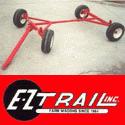 |
 |

|
|
|
Iowa Ag News Headlines |
 |
NASS Reviews 2018 Iowa Crop Year
Iowa Ag Connection - 12/11/2018
Winter weather lingered through the third week of April preventing fieldwork and planting activities to a strong degree. Despite frequent weather interruptions throughout May, planting was nearing completion with 96 percent of the corn and 81 percent of the
soybeans in the ground by May 27. Corn planting was completed in the first week of June and soybeans were finished by the third week of June. The week ending July 29 saw the highest number of days suitable for field work for the season with 6.3 days
suitable. Counties in the northern two-thirds of Iowa received regular precipitation from the beginning of April through the end of June with double-digit totals reported in consecutive weeks in some areas. However, the southern one-third of the state received
little precipitation with severe drought conditions for much of July and August. Temperatures climbed to seasonal highs and took a major toll on declining pastures and soil moisture supplies in south central and southeast Iowa. Despite planting delays crop
development progressed rapidly and was generally either equal to or ahead of the average pace. Iowa farmers were able to get an earlier than average start on corn and soybean harvest but were hindered by very wet conditions following storms throughout
September and first two weeks of October. As a result, corn harvest progress slipped behind average the second week of October and remained behind for the rest of the season. Soybean harvest progress fell behind average after the first week of October and
remained behind average through the last week of November. By the end of November only a few areas of the State had reports of crops remaining to be harvested.
Corn planting was limited in the month of April due to persistent winter weather conditions. By April 29, only 17 percent of the corn crop was planted, 3 days behind last year and the 5-year average. Planting progress remained behind average through May 20
but was virtually complete by June 3. Despite planting delays, crop development moved ahead of last year for most of the season. Corn was almost fully emerged by June 17, a week ahead of average. Corn silking was virtually complete by August 5, 12 days
ahead of average. Ninety-eight percent of corn had reached dough stage by September 9, 5 days ahead of average. Ninety-nine percent of corn was at or beyond the dent stage by September 30, 5 days ahead of average. Corn began reaching maturity by the
third week of August, and remained ahead of the five-year average for the rest of the stage. Corn for grain harvest got off to an early start in the second week of September, 3 days ahead of average but fell behind the second week of October following heavy
rains and early snowfall. Drier conditions in the weeks ending October 27 and November 4 allowed Iowa farmers to harvest 43 percent of their corn for grain to reach 72 percent, but progress still remained behind average. Corn harvested for grain was nearly
complete at 96 percent on November 25. Corn condition rated a season high 84 percent good to excellent on June 17. Moisture of corn being harvested was reported at 22 percent as harvest began and gradually fell to 16 percent by the final 3 weeks of
harvest.
Soybean planting started the last week of April, matching the 5-year average and never fell behind pace despite frequent rain and late spring snowstorms. From May 13 through June 17 soybean planting progress stayed 5 percentage points or more ahead of the
5-year average. Planting was nearly complete by June 10, 1 day ahead of last year and 2 weeks ahead of average. By the end of May, 44 percent of soybeans had emerged, 3 days ahead of average. Soybean emergence was virtually complete by June 24.
Plants began blooming in late June, and remained ahead of the average pace throughout with 98 percent blooming by August 19. Pods set were either equal to or ahead of average for the entire stage. Leaves turning color started off slow, but neared completion
at 99 percent on October 7, 4 days ahead of average. Harvest began slowly in mid-September, and remained behind the 5-year average from October 1 through completion. During the 2 weeks from October 14 through October 28 Iowa farmers harvested 52
percent of the soybean crop, reaching 71 percent harvested. Crop condition peaked at 80 percent rated good to excellent on June 17. Rain and early snow accumulation in the first half of October degraded crop condition to a season low 65 percent rated good
to excellent by the week ending October 14.
Oat seeding began in late March but was frequently interrupted by extended periods of winter weather accompanied by cold temperatures. By the end of the first week of April planting progress was a week behind average and remained at least a week behind
until the second week of May. Seeding was complete by the end of May. Cold temperatures delayed emergence which did not catch up to the average until May 27 at 95 percent emerged. By June 10, 99 percent of the oats were emerged with 38 percent at
the headed stage. At the start of July, heading and coloring were slightly ahead of average. Nearly three-quarters of the crop was turning color by July 15. Ninety-five percent of the oat crop had been harvested by August 19, 4 days behind the average. On
May 20 the condition rating for the crop was 78 percent good to excellent. The condition peaked at 83 percent good to excellent on June 17 and gradually declined to 75 percent by the end of the season.
The first cutting of alfalfa hay was 22 percent complete by May 27, 4 days ahead of the 5-year average. The crop condition peaked near the end of the first cutting on July 1 with 74 percent of the State's hay rated good to excellent. The first cutting was nearly
complete by July 1, with 24 percent of the second cutting also complete. Ninety-three percent of the second cutting was complete by July 29, 11 days ahead of average. Frequent storms producing heavy rain interrupted hay cutting and baling in the northern
two-thirds of the State, while counties in the southern one-third of the State experienced drought conditions. Both extremes caused the deterioration of hay condition ratings from the beginning of July through mid-August, ending with a season low 52 percent of
the State's hay rated good to excellent. The third cutting did not get started until the third week of July, 6 days behind the previous year and remained behind until completion. Some producers in Iowa were able to complete a fourth cutting of alfalfa hay.
Pasture growth was slow to begin due to persistent cold, wet weather. As May began conditions finally supported pasture development. By June 24, 77 percent of the State's pastures were in good to excellent condition. Pasture conditions soon began to
deteriorate and by August 19 condition ratings hit a season low with just 41 percent rated good to excellent. At this point supplemental feeding of hay and using CRP acres for emergency haying and grazing were required in parts of the State affected most by the
drought conditions. Rain and cool temperatures in October helped conditions rebound at the end of the season. The last rating of the season showed 52 percent good to excellent.
The Crop Progress and Condition Report is made possible by the dedication of the many farmers, FSA, NRCS, Extension, and agribusiness personnel who provide information each week.
|
 |


|
 |
|
Copyright © 2024 - Farms.com. All Rights Reserved. |
 |
|